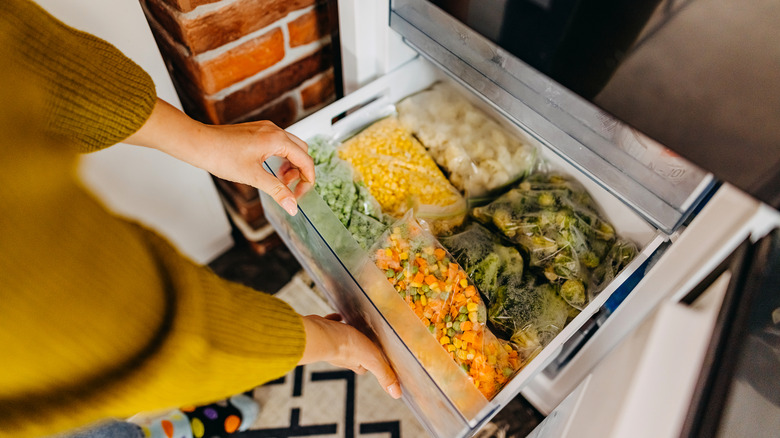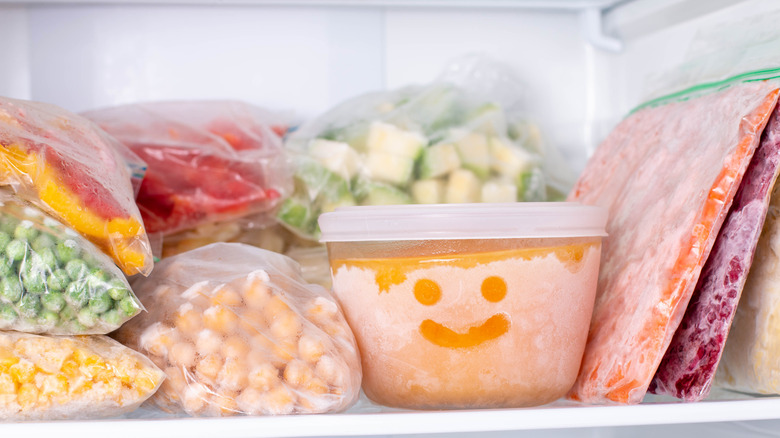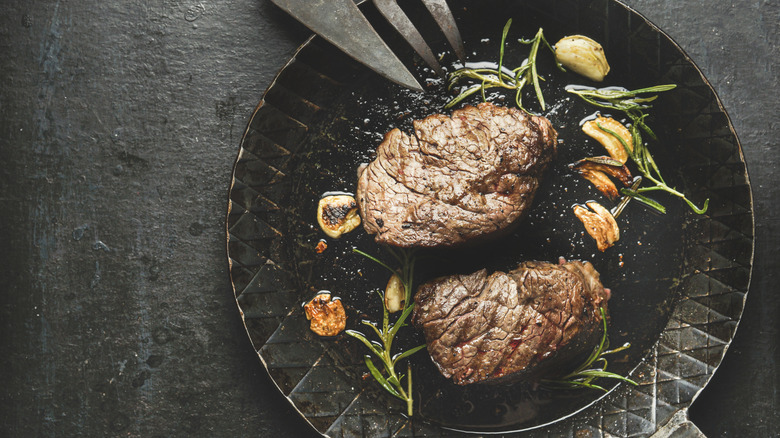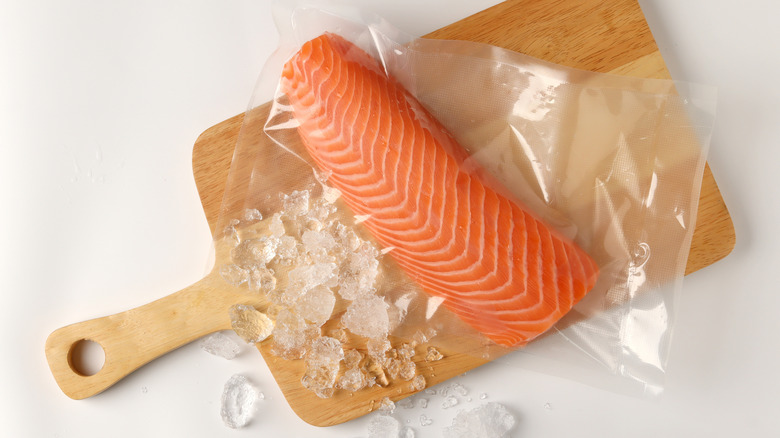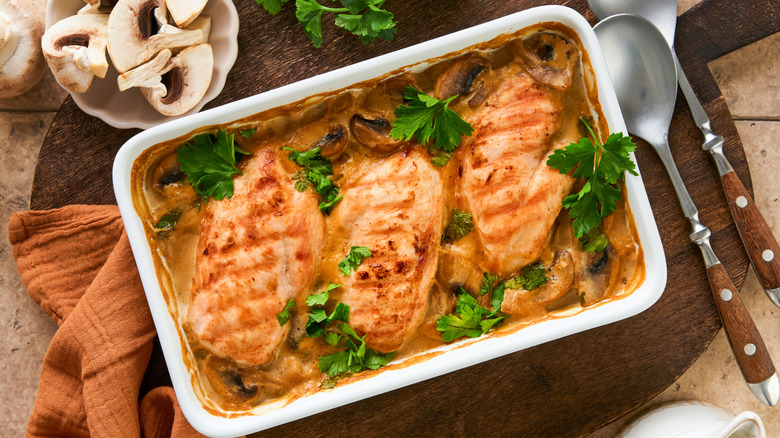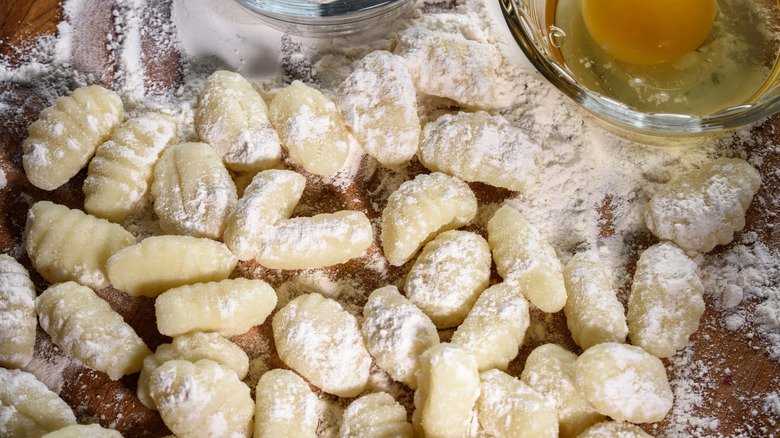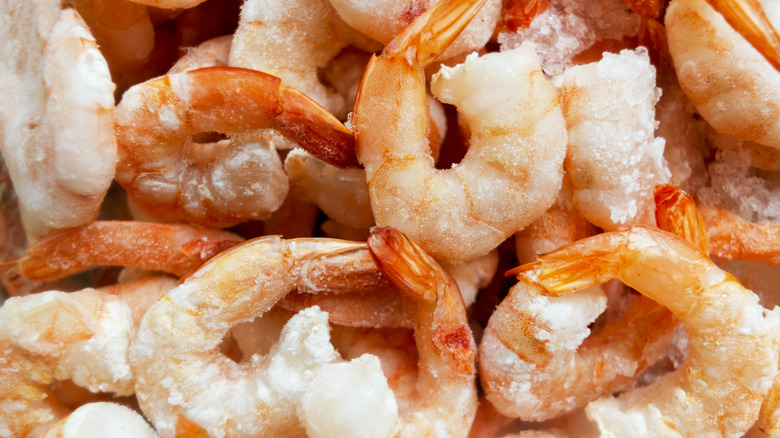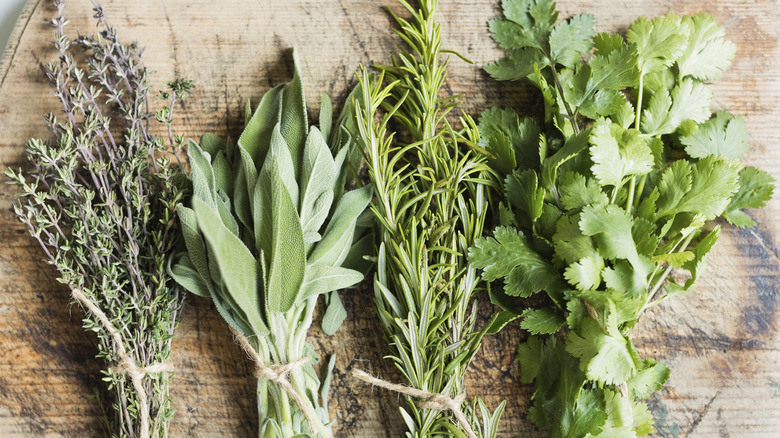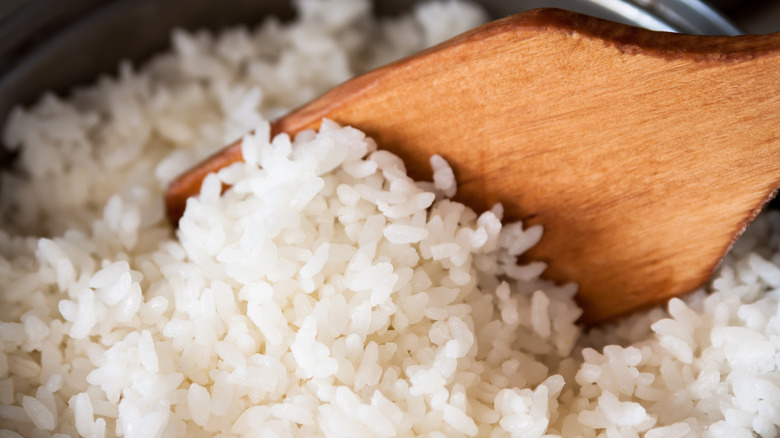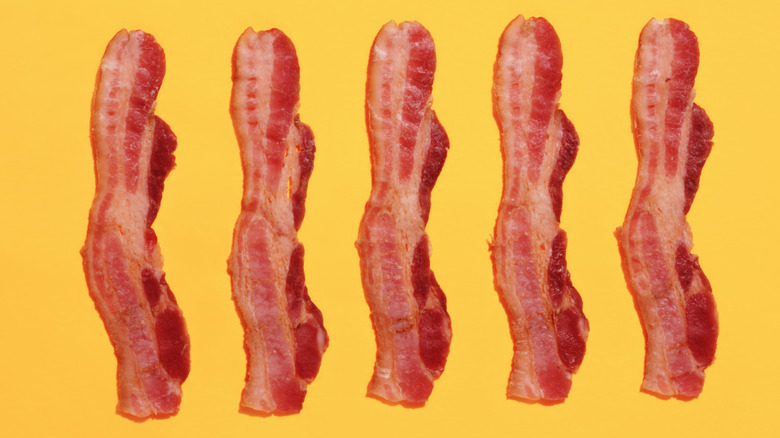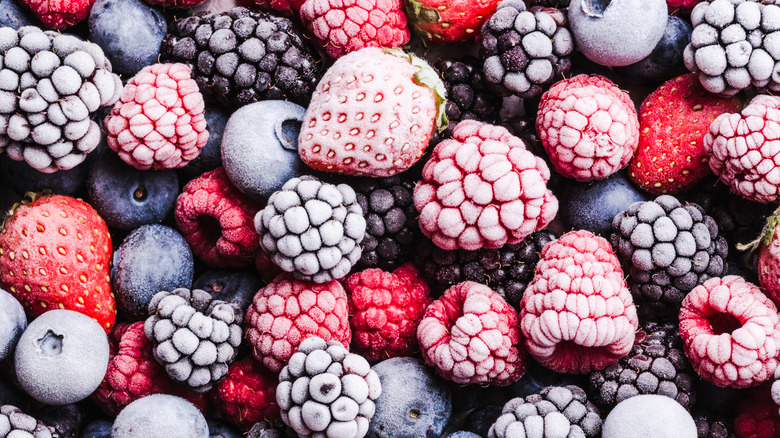Experts Recommend Cooking These Frozen Foods Straight From The Freezer
The freezer is such a great invention for convenience. It was in 1927 that General Electric started selling freezers to the public en masse. Before that, we got by with a dangerous ammonia and sulfur dioxide gas freezer that was eventually discontinued. Further back in history, the icebox was used. It was a wooden crate insulated with straw or cotton and lined with zinc. A large ice block was placed inside to keep food from spoiling, but would only last about a week before it needed to be replaced.
We're thankful for the modern freezer that houses our pre-cooked meals, plastic containers of batch cooking, chicken nuggets, fish fingers, berries, ice cream, pizza bases, and ice for the drinks. If you leave your freezer door open by mistake, this heavenly supply could thaw out. (Cue freezer drawers that are jammed shut, and break while you try to yank the plastic basket free.) A small joy for the home cook is a clean and organized freezer where you can see what's in there and access it. If your freezer is disorganized, a bit bare, or you're bored with the usual convenience meals, Mashed has researched the different foods you can freeze — and cook straight from frozen.
Vegetables
Kate Hall is the founder and author of The Full Freezer. Her five-step approach helps home cooks reduce food waste, save money, and enjoy a wide range of meal options by using their freezers more effectively. In an interview with Mashed, she recommends freezing almost everything and anything if there's a risk of it ending up in the bin. "The foods that can be frozen, that tend to surprise people most are nuts, fruits, and eggs (out of their shells)," she shares.
Hall says she often freezes vegetables to avoid them going to waste. "Vegetables are undoubtedly best cooked from frozen. By cooking frozen veg over a high heat (particularly sautéing, air frying, or roasting) the excess moisture evaporates quickly and best preserves the texture, stopping them from going soggy and limp," she explains. When freezing some vegetables (like sweet potato, broccoli, and cauliflower), Hall recommends blanching them first. "This is the process of placing the veg in boiling water and then ice water to deactivate enzymes which deteriorate the quality. I find that by doing this, it also helps them to cook more evenly, especially if you are roasting or air frying." Her additional tips for cooking veg from frozen is to make sure the baking tray or pan is not overcrowded so steam can escape. And if you are boiling or steaming veg that has been blanched then keep a close eye on it and reduce the cooking duration by the time it was blanched for.
Steak
You can cook steak directly from frozen. This is a game changer for the busy home cook. "Smaller pieces of protein like boneless steaks can be grilled directly from frozen with excellent results," confirms ButcherBox chef-in-residence, Ashley Lonsdale. The biggest challenge, she says, is the frozen protein can't take on any seasoning before cooking, but there are ways to circumvent that with sauces and seasonings during and after cooking.
Grilled New York strip steak with a green sauce (like chimichurri) and steamed rice is one of Lonsdale's quick and easy favorites. "Frozen steaks cook easily under high heat," she explains, recommending broiling and grilling as a good method because it encourages rapid moisture evaporation and browning. Frying frozen steak "is not ideal," she says. Cooking meat from frozen can be risky if not done correctly. "Ensure even cooking and safe internal temperatures, of around 160°F for ground meats, and 165°F for poultry," advises certified food scientist Jessica Gavin. "Use an instant-read thermometer to test, adjust cooking times as needed, and maintain a consistent temperature," she adds. Gavin, who is also a chef, uses the reverse sear method when she cooks her steak from frozen. "I cook it in the oven at 275°F until nearly done, then sear it in a hot pan for one to two minutes per side to develop a flavorful crust," she explains. Another tip from Gavin is to cut raw steak into smaller, uniform fillets before freezing, for quicker cooking.
Fish
Fish is still healthy and delicious when cooked directly from frozen. It's not recommended to cook a whole fish straight from frozen because harmful bacteria can grow if safe internal temperatures aren't reached quickly enough, this applies to meat too. "Ensure internal temperatures, of around 145°F for fish," advises Ashley Lonsdale. Fillets are the best cut of fish when cooking from frozen. Before you get started, buy fillets that are the same size and not too dense, this will set you up for a successful cook.
One of the best ways to cook fish from frozen is by broiling it. "Broiling is a handy technique when cooking from frozen," explains Lonsdale, whose favorite direct-from-frozen fish dish is broiled salmon with roasted vegetables and fresh dill. "Salmon fillets cook easily under high heat. If you're cooking fish with skin, broil skin side up for charred and crispy skin," she clarifies. Fish still retains its nutrients when cooked from frozen. Food scientist Jessica Gavin recommends using lower temperatures and shorter cooking times to get the best out of your frozen fish. "Fish, like salmon, retain nutrients like omega-3 fatty acids better when poached or baked rather than deep-fried, as high heat can degrade these nutrients," she points out.
Chicken
The best chicken pieces to cook from frozen are chicken breasts and chicken thighs, say the food bloggers and chefs Mashed spoke to. Baking frozen chicken breasts is also Ashley Fehr's preferred method for well-seasoned chicken when she wants it to be the stand-alone protein in her family's main meal. "When I'm baking frozen chicken breasts, I like to give them a 20-minute head start in the oven, and then go in and add some seasoning or sauce," says the cook behind The Recipe Rebel. "I find that it sticks better to chicken that is not frozen solid, and if I am using sauce it doesn't burn with the long cook time." Fehr cooks her chicken breast at 400°F in a baking dish and covers it with foil for the first half of the 40-minute cook. Make sure the thickest part of the fillet is 165°F right through when cooking chicken breasts from frozen. If it isn't cooked through and piping hot, "this will encourage bad bacteria to develop," Kate Hall advises.
According to a 2023 study published by the USDA, customers were expected to ingest an annual average of 100 pounds of chicken each that year, while they were predicted to consume 57.4 pounds of beef, and 50 pounds of pork. Another way to enjoy this popular protein from frozen is by poaching boneless, skinless chicken thighs in a spicy coconut curry. Ashley Lonsdale suggests this for creating a quick, gourmet meal, direct from frozen.
Freshly prepared gnocchi and pasta
Unless you own a pasta machine or want to prepare gnocchi from scratch, it's unlikely you're regularly freezing these two Italian carbs. But it's not too late to start. If you're overproducing tagliatelle or only using two servings of the big batch of potato gnocchi you made for dinner, freeze it and cook it straight from frozen — next time you feel like a pasta night. "You can leave [uncooked] gnocchi in the freezer for up to three months before you cook it," chef and recipe developer Maren Epstein of Eating Works told Mashed. "Gnocchi doesn't keep well once it has been cooked, so I would freeze them and cook right before you serve. They only take three minutes to make [from frozen]."
Prepared ravioli or tortellini meals from the store can also be cooked directly from frozen. It isn't necessary to thaw them first, just follow the package instructions and cook as normal. Fresh pasta should be eaten within 18-24 hours of making it. There are ways to store fresh pasta in the freezer to ensure an easier cooking process. Lay the pasta out on a baking sheet or towel to air dry it for an hour or two. Make sure you dust the pasta with flour then wrap it into little nests, or lay it out in a single layer and freeze it in an airtight bag or container. Like the gnocchi and ravioli, cook it directly from frozen, as you normally would.
Shellfish
Another great option for the freezer that you can cook directly from frozen is shrimp and scallops. The frozen section of the supermarket is where you'll find prepared frozen shrimp and scallops. They will be uncooked. The shrimp is usually shelled and deveined (double check the packaging — this is what you're looking for) and the scallops will be wild-caught and frozen at sea.
"Seafood can be cooked from frozen by poaching it in a flavorful liquid, which provides an opportunity to introduce flavor and seasoning during the cooking process," suggests ButcherBox chef-in-residence, Ashley Lonsdale. A Thai shrimp curry would be a good option as the shrimp can poach in the curry-infused coconut milk. For convenient summer barbecue vibes, Lonsdale recommends preparing herby sauces to swipe over grilled shrimp or scallop skewers. You can throw your frozen shellfish directly into the pot or briefly run cold water over it before cooking. "This raises the surface temperature, slightly reduces thermal shock, and reduces the risk of uneven cooking," says food scientist Jessica Gavin. "Just make sure that the water stays below the danger zone of 40ºF to 140ºF, where bacteria can rapidly multiply and cause food-borne illness."
Herbs
It's handy to have fresh parsley, coriander, mint et al in the drawer of your fridge for garnishing pasta and stir-fries or for making tea (in the case of mint). However, when the weekly or bi-monthly fridge clean-out happens, these small containers of limp, brown herbs get binned first.
Kate Hall has several techniques for freezing and reusing herbs before they spoil. First off, she recommends pruning off the wilted stems, washing the remaining leaves, shaking off the excess water, and bagging them in a plastic freezer bag (remember to squash the air out before you seal and if you're freezing a few different varieties, label the bags so you're not confused down the line.) These frozen herbs can't be used for garnishing, but they can be added to soups, sauces, or stews to add flavor to the dish, just pull out what you need and add them to the pot. "If you prefer, you can also portion your herbs out into cubes and top up with water or oil, or mix with softened butter and freeze in discs," says Hall.
Cooked rice
Portioning rice isn't always a successful task. You can use a cup or two and overcater for what's needed that day. The good news is, that leftover rice can be frozen and used for a busy weeknight dinner when you need a convenient option. Kate Hall's rule of thumb is to use frozen food within three to six months, as long as your freezer is consistently cold enough at -0.5°F and the food is well wrapped. Her disclaimer is that bulky food like vacuum-packed joints of meat can last up to a year.
Use a plastic freezer bag to store rice to prevent it from drying out due to freezer burn. "Freezer burn is the dehydration of your food. It's where the moisture in the cells of the food migrates onto the surface and into the freezer. By wrapping your food tightly, and not keeping food in the freezer for too long you can avoid freezer burn," explains Hall. Freezer burn isn't unsafe, it just dries out food. Reheating frozen rice is quick and easy. When you're ready to use it, just add a tablespoon or more of water and reheat it in the microwave (about three minutes) or on the stovetop with a lid until it's thoroughly steaming.
Bacon
The USDA doesn't recommend thawing frozen bacon on the kitchen counter or at room temperature because bad bacteria from the surroundings can be introduced to the food. It's instead advised to use a refrigerator, cold water, or the microwave to defrost bacon. Better yet, cook your bacon directly from frozen. Kate Hall has a genius method to avoid trying to break up clumps of frozen bacon strips on a Saturday morning.
Using a baking tray with wax paper, roll up each piece of bacon, place them a distance apart, and freeze it. If you have enough space in the freezer for the tray long-term, that's great! If not, place the frozen bacon rolls together in an airtight container. Each time you need a piece or two of bacon, grab what you need from the bacon vault. This meat will naturally unfurl when cooked on the stovetop, in the oven, or air fryer. Cook until crisp.
Fruit
Fruits don't defrost well but are great for "smoothies, baking and as frozen snacks," recommends frozen food expert Kate Hall. Have you ever tried to freeze overripe bananas? You peel and chop them up, and stick them in a plastic container at the back of the freezer drawer only to have to chisel off what you need each time you make a smoothie. Hall's method of pre-freezing chopped fruit and veg before placing it in "deep storage" makes cooking fun and easy.
It's similar to how she freezes bacon. Chop up the pieces of fruit you want to freeze (bite-size pieces will do). If it's blueberries or strawberry-size fruit, keep it whole. If it's apple, peel it first. Place the fruit evenly spaced on a baking sheet, on a baking tray, and put it in the freezer until frozen (about two hours). Then add your fruit into a freezer bag. "By doing that first, they're not going to all stick together, and then you're going to be able to use just as much as you want." For a real treat, Hall recommends dipping your frozen fruit in melted dark chocolate and popping it straight back in the freezer. Plastic freezer bags can be washed and reused, and at the end of their lifecycle, can be recycled.
